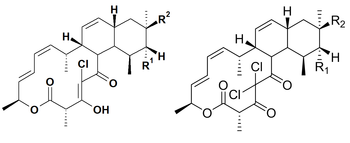Highly active Chlorotonil A Derivatives for the treatment of Malaria
Challenge
Nearly half of humankind (3,2 Mrd. People) are threatened by the risk of infection by malaria, this burden being highest in the African Region. According to the World Health Organisation (WHO) the parasitic disease, which is transmitted by Anopheles mosquitos infected by different Plasmodium strains, caused about 216 million cases of malaria in 91 countries in 2016, an increase of 5 million cases over 2015, and was responsible for 445.000 deaths worldwide. Resistance to antimalarial drugs is a recurring problem. After the development of resistance against chloroquine and sulfadoxine-pyrimethamine, now increasing resistance to artemisinin is being observed. Most of the currently used antimalarial drugs target the pathogen in the stage of erythrocytic schizogony (e.g. Artemisinin, Chloroquin). However, a more promising approach to control the spreading of the pathogen and for final eradication would be to target the gametocytes in order to prevent the transmission and reinfection of the primary host, the Anopheles mosquito.
Technology
Provided are new derivatives of the natural macrolide antibiotic Chlorotonil featuring improved water solubility and bioavailability. Chlorotonil A is produced by the myxobacterium Sorangium cellulosum and shows high activity in the low nanomolar range and a novel mechanism of action against plasmodia parasites in all intraerythrocytal stages (also gametocytocidal activity in late stages IV-V). It is also effective in a P. berghei mouse model at doses as low as 36 mg/kg. The orally available inventive semi-synthetic derivatives feature improved pharmacological properties with low toxicity and enhanced gametocytocidal activity against P. falciparum. The IC50 of the frontrunner derivative is 0.93 nM against P. falciparum and 2.2 nM against a chloroquine resistant strain. In addition, Chlorotonil is active against relevant Gram-positive pathogens such as VRE and MRSA. Furthermore, the gene cluster has been identified and characterized and the fermentative production process and semi-synthesis has been established. A total synthesis of Chlorotonil A is available as well.
Commercial Opportunity
The invention is offered for licensing or co-development.
Development Status
Optimization of the production strain is still to be done. Further derivatives of Chlorotonil A (and Chlorotonil B) are under investigation.
Patent Situation
A European priority application has been filed in November 2017.
Further Reading
Jungmann et al. 2015. Two of a kind - The biosynthetic pathways of chlorotonil and anthracimycin. ACS Cem Biol. 2015;10(11):2480-90.
Held et al. 2014. Antimalarial activity of the myxobacterial macrolide chlorotonil a. Antimicrob Agents Chemother. 2014 Nov;58(11):6378-84.
Gerth et al. 2008. Chlorotonil A, a macrolide with a unique gem-dichloro-1,3-dione functionality from Sorangium cellulosum, So ce1525. Angew Chem Int Ed Engl. 2008;47(3):600-2.
Rahn and Kalesse 2008. The total synthesis of chlorotonil A. Angew Chem Int Ed Engl. 2008;47(3):597-9.




